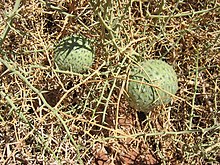Cucurbitoideae
Appearance
| Cucurbitoideae | |
|---|---|

| |
| Acanthosicyos horridus, a member of the Cucurbitoideae native to Namibia | |
| Scientific classification | |
| Kingdom: | Plantae |
| Clade: | Tracheophytes |
| Clade: | Angiosperms |
| Clade: | Eudicots |
| Clade: | Rosids |
| Order: | Cucurbitales |
| Family: | Cucurbitaceae |
| Subfamily: | Cucurbitoideae Eaton |
| Tribes | |
The Cucurbitoideae are a subfamily of the flowering plant family Cucurbitaceae (gourds). The Cucurbitaceae are divided into two subfamilies, the Zanonioideae, probably a paraphyletic group of remainders, and the well-supported monophyletic Cucurbitoideae.[1]
The subfamily Cucurbitoideae consists of eight tribes. Members of the tribe Cucurbiteae produce economically valuable fruits, called gourds, which include crops like squashes (including pumpkins), luffas, and melons (including watermelons).[2] The tribe Benincaseae contains a genus called Lagenaria whose members produce gourds that can be eaten when young or whose ripe shells can be dried and used as containers.[3]
References
- ^ Donoghue, Michael J.; Judd, Walter S.; Campbell, Christopher; Elizabeth A. Kellogg; Stevens, Peter F. (2008). Plant Systematics: A Phylogenetic Approach. Sunderland, Mass: Sinauer Associates. ISBN 0-87893-407-3.
- ^ Mabberley, David (2008). Mabberley's Plant-Book: a Portable Dictionary of Plants, their Classification and Uses. Cambridge, UK: Cambridge University Press. ISBN 0-521-82071-5.
- ^ "Lagenaria Ser". Germplasm Resources Information Network (GRIN). United States Department of Agriculture. Archived from the original on October 29, 2013. Retrieved September 2, 2013.
External links
Wikispecies has information related to Cucurbitoideae.
Wikimedia Commons has media related to Cucurbitoideae.
